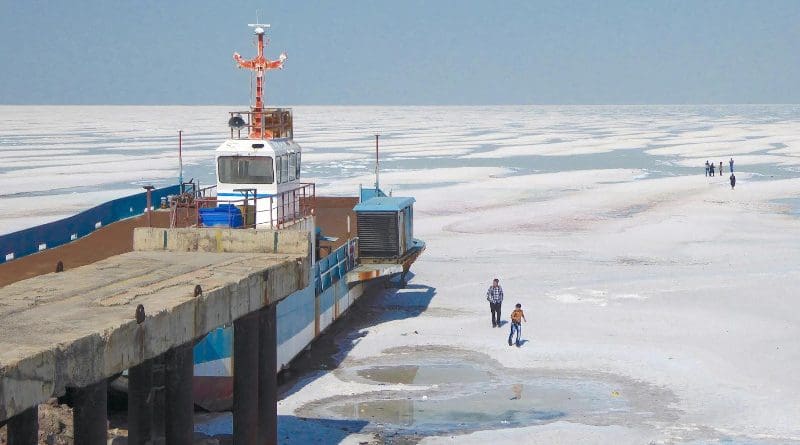Iran: 95% Of Lake Urmia Has Dried Up
By Hossein Beizayi
Lake Urmia in northwestern Iran is 140 km from north to south and 80 km from east to west, and with a total area of 5,200 square kilometers, it was the largest saltwater lake in the world after the Caspian Sea until the last two decades. But unfortunately, about 95% of the lake has dried up and disappeared according to a government official. In 1978, UNESCO registered Lake Urmia and its ecosystem among the world’s natural and protected monuments.
Interestingly, the fossils of 47 species of living organisms have been recorded in the area of Lake Urmia so far. This means that this part of Iran has always been an important point for the migration of birds and animals. Lake Urmia is home to a crustacean named Artima, a food source for many migratory birds, especially flamingos. Urmia Artemia has a beautiful pink color; feeding on it makes flamingos have pink feathers. With all its unique features, Lake Urmia is facing destruction due to the greed and the negligence of the authorities, and this historical lake is drying up and turning into dry salt lands at a very fast rate.
Iran’s regime behind the Lake Urmia disaster
The construction of 35 dams on 21 rivers feeding Lake Urmia has played an important role in the drying up of the once flourishing lake. Currently, nearly 50 billion cubic meters of water have been taken from Lake Urmia with the construction of the above-mentioned dams, which have dried up about three thousand square kilometers. Regime authorities have planned the death of the lake by indiscriminately building numerous dams and deep wells, creating a bypass road on the lake, and polluting it with industrial wastes.
Amir Abbas Jafari, the Director General of Crisis Management of West Azarbaijan Province, said recently that 95% of the water in Lake Urmia had dried up and said that this was unprecedented in the last two decades and that the height of this lake has decreased by an average of 40 cm every year. Jafari said the most important factors behind the death of Lake Urmia were drought, excessive development of agriculture, and the improper use of lake water for growing crops that need a lot of water. He expressed hope that proper cultivation and proper use of water resources in the region would lead to the revival of the lake.
In the last years, there has been no shortage of superficial statements of concern, national and provincial plans, speeches and promises, etc., to solve the Lake Urmia crisis, but none of them were implemented. What is certain is that this beautiful lake is not far from certain death. The drying up of Lake Urmia, in addition to having been a full-scale environmental disaster, has also led to a human, social and economic crisis because it has destroyed livestock, agriculture, and tourism in the surrounding provinces.
A society that does not support and preserve its natural resources and ecosystem is doomed to prepare itself for self-destruction. Human life sustainability is in close connection with nature and all its resources, and any damage or major deterrence to nature will inevitably be a blow to human life. In the regime of the mullahs, the country has been deprived of many of its human potential and natural resources. Contrary to some views, the issue of the ecosystem is not secondary and lateral but fundamental and essential, and the current destruction of natural resources in Iran is irreparable. Based on their ideological, political, and economic visions, Iran’s authorities have shown that they are against the preservation of the environment.
There is a huge void of modern water supply networks and modern management methods in today’s Iran and what is implemented is disastrous. In Iran, the productive, industrial and urban use of water is abnormal, and the management of water resources is illogical, politicized, inappropriate, and unwise, which will inevitably worsen the ecological crisis of water to the point of no return. Many experts believe that the main cause of this crisis has been and is government policies and government institutions. In many countries, the proper management of natural resources has largely contained the crisis caused by natural factors. According to the United Nations, Iran is one of the countries rapidly losing its natural and water resources.

